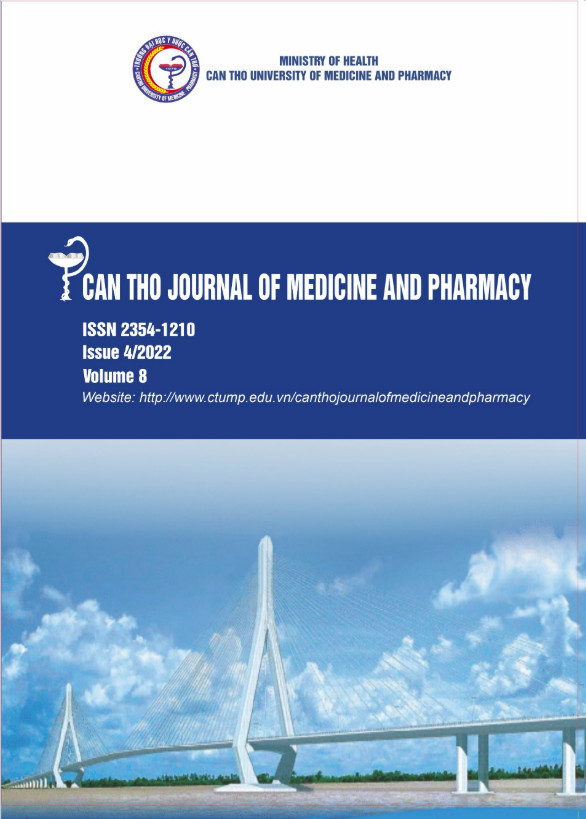MEDICAL STUDENT'S MENSTRUAL CYCLE: THE UNKNOWN UNKNOWNS
Main Article Content
Abstract
Background: The menstrual cycle is a health indicator in women. The change in health makes female students feel less confident in communicating, studying, and living. Therefore, the study on the characteristics of the menstrual cycle in female medical students brings many practical meanings by figuring conclusions and solutions to improve both physiological and mental discomforts for women during menstruation. Objectives: Can Tho University of Medicine and Pharmacy (CTUMP) 3rd year medical students were studied for the characteristics, the abnormalities of the menstrual cycle, and the premenstrual syndrome. Materials and methods: The design of a cross-sectional descriptive study with analysis by direct interview method was conducted on 126 female 3rd year medical students at CTUMP. Results: Long menstrual cycle time accounted for 38.1% of subjects, while short menstrual cycle time accounted for 0.8%. The study also found that the average menstrual period was 5.00±1.34 days. The premenstrual syndrome was observed in 47.3% of students, with abdominal pain and low back pain accounted for the highest rate (63.5%), and headache accounted for the lowest rate (9.5%). Menorrhagia had a low prevalence (7.1%), whereas menstrual cramp was much more common (60.3%). Conclusions: Long menstrual cycles occurred at a high rate among medical students. Abdominal pain and low back pain were the most common symptoms before menstruation. Menstrual cramp was the most common abnormality of the menstrual cycle among CTUMP female medical students.
Article Details
Keywords
girls, menstrual cycle, medical student, Can Tho
References
2. Ansong, E. et al. (2019), “Menstrual characteristics, disorders and associated risk factors among female international students in Zhejiang Province, China: a cross-sectional survey”, BMC Womens Health, No. 19(1).
3. AnupriyaAgarwal, AnnapoornaVenkat (2009), “Questionnaire Study on Menstrual Disorders in Adolescent Girls in Singapore”, Journal of Pediatric and Adolescent Gynecology, Vol. 22(6), pp. 365-371.
4. Doan Van M. et al. (2021), “Survey on Characteristics Clinical of Dysmenorrhea and the Need for Treatment with Traditional Medicine of Female Students of Hue University of Medicine and Pharmacy”, Journal of Medicine and Pharmacy, pp. 79-86.
5. Hamza M. Abdulghani et al. (2011), “Stress and Its Effects on MedicalStudents: A Crosssectional Study at a College of Medicine in Saudi Arabia”, J health popul nutr, No. 29(5), pp. 516-522.
6. Kiesner, J. et al. (2016), “Cyclical symptom change across the menstrual cycle: Attributional, affective, and physical symptoms”, Clinical Psychological Science, No. 4(5), pp. 882-894.
7. Kiesner, J., T. Eisenlohr-Moul, and J. Mendle, (2020), “Evolution, the Menstrual Cycle, and Theoretical Overreach”, Perspectives on psychological science: a journal of the Association for Psychological Science, No. 15(4), pp. 1113-1130.
8. Mark E Schoep et al. (2019), “The impact of menstrual symptoms on everyday life: a survey among 42,879 women”, Original research gynecology, Vol. 220(6), pp. 569.E1-569.E7.
9. Nazish Rafique N, Al-Sheikh MH (2018), “Prevalence of menstrual problems and their association with psychological stress in young female students studying health sciences”, Saudi Med J., No. 39(1), pp. 67-73.
10. Nguyen Thi Thu Thuy, Le Thi Vu Huyen (2021), “Knowledge of stress of 3rd year medical students”, Hanoi Medical University, Vietnam medical journal, No. 2, pp.168-173.
11. Reed BG, Carr BR (2020), “The Normal Menstrual Cycle and the Control of Ovulation”, South Dartmouth (MA).
12. Shahpar Najmabadi et al. (2020), “Menstrual bleeding, cycle length, and follicular and luteal phase lengths in women without known subfertility: A pooled analysis of three cohorts”, Peadiatric and perinatal epidemiology, Vol. 34(3), pp. 318-327.
13. Sriwijaya Fildzah Hasifa Taufiq, Herry Hasnawi, Rachmat Hidayat (2020), “Stress Induces Menstrual Cycle Disturbance Among Female Students in Faculty of Medicine Universitas”, Bio Sc Med, No. 3(1), pp. 1-13.


